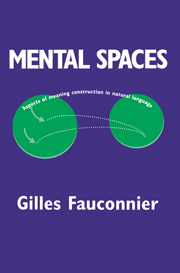Book contents
- Frontmatter
- Contents
- Foreword
- Preface
- Acknowledgments
- Introductory Note
- 1 Pragmatic Functions and Images
- 2 Roles and Multiple Connectors
- 3 Presuppositions: Floating, Transfer, and Projection Strategies
- 4 Counterfactuals and Comparatives
- Chapter 5 Transspatial Operators, Philosophical Issues, and Future Perspectives
- Notes
- References
- Index
Chapter 5 - Transspatial Operators, Philosophical Issues, and Future Perspectives
Published online by Cambridge University Press: 20 January 2010
- Frontmatter
- Contents
- Foreword
- Preface
- Acknowledgments
- Introductory Note
- 1 Pragmatic Functions and Images
- 2 Roles and Multiple Connectors
- 3 Presuppositions: Floating, Transfer, and Projection Strategies
- 4 Counterfactuals and Comparatives
- Chapter 5 Transspatial Operators, Philosophical Issues, and Future Perspectives
- Notes
- References
- Index
Summary
“Le rendez-vous est dehors,” dit Théodule. “Voyons la fillette.”
Et il s'avança sur la pointe de ses bottes vers l'angle où Marius avait tourné. Arrivé là, il s'arrêta stupéfait.
Marius, le front dans ses deux mains, était agenouillé dans l'herbe sur une fosse. II y avait effeuillé son bouquet. A l'extrémité de la fosse, à un renflement qui marquait la tête, il y avait une croix de bois noir avec ce nom en lettres blanches: Colonel Baron Pontmercy. On entendait Marius sangloter.
La fillette était une tombe.
Victor Hugo, Les MisérablesTransspatial Operators
Be
Many verbs, perhaps a majority, establish relations within spaces. Others (for example, believe, paint, prevent, look for, wish) set up new spaces.
The verb (or copula) be has special properties. First, it can be used very generally to link a trigger and its target, when the relevant pragmatic function (connector) is known:
(1) Plato is the red book; Homer is the black book.
(Connector: “writers → books”)
(2) The gastric ulcer is Peter Smith.
(Connector: “illnesses → patients” (in a hospital))
(3)
We are the first house on the right.
(Connector: “people → houses they live in”)
(4)
I'm the ham sandwich; the quiche is my friend.
(Connector: “customers → food they order”)
(5)
Getty is oil, Carnegie is steel, Vanderbilt is railroads, (cf. Fife (1979))
(Connector: “magnates → product controlled”)
(6)
In that picture, Lisa is the girl with blue eyes.
(Image connector: “models → representations”)
(7)
In that movie, Cleopatra is Liz Taylor.
Information
- Type
- Chapter
- Information
- Mental SpacesAspects of Meaning Construction in Natural Language, pp. 143 - 167Publisher: Cambridge University PressPrint publication year: 1994
